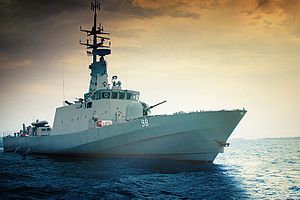A Singapore navy vessel successfully disrupted a sea robbery on a Malaysian-flagged tugboat Tuesday.
According to a September 1 press release issued by the Ministry of Defense (MINDEF), the Republic of Singapore Navy’s Maritime Security Task Force (MSTF) had immediately deployed its Fearless-class patrol vessel the RSS Resilience upon receiving a report from the boat – Permata 1 – at around 9am as it was transiting the Singapore Strait.
As I noted in a previous piece, the Fearless-class patrol vessels have been in service with the Republic of Singapore Navy (RSN) for around two decades and are responsible for the city-state’s coastal defense (See: “What Do We Know About Singapore’s New Warship”). The 55-meter vessels boast a speed in excess of 20 knots, a range of 1,800 nautical miles and can carry a crew of 30. In terms of weapons, they are equipped with a 76 mm OTO Melara SRGM, a Mistral Surface-to-Air Missile or Typhoon Mk 25 Gun, and four CIS 0.5” machine guns. They will be replaced by the new locally-made Littoral Mission Vessel (LMV).
The robbers fled towards Indonesian waters upon seeing the warship, MINDEF said in a press release. The RSN’s Information Fusion Center (IFC) then shared information with the Indonesian Navy’s (TNI AL) Western Fleet Sea Security Group and the Malaysian Maritime Enforcement Agency, which led to the TNI AL successfully apprehending the robbers and recovering the stolen cargo. The IFC, which was inaugurated in April 2009, is an information-sharing center which facilitates collaboration between partners to enhance maritime security. The RSS Resilience then accompanied Permata 1 safety into Singapore waters where the Police Coast Guard boarded it for investigation.
“I am heartened to see the good cooperation between Singaporean, Indonesian and Malaysian enforcement agencies in disrupting the sea robbery attempt on Permata 1,” said Rear-Admiral Frederick Chew, commander of the MSTF.
“In particular, the close cooperation between the RSN and TNI AL is a reflection of the strong ties between our navies. We need to continue working closely together to keep up the pressure on sea robbers and to bring sea robbery incidents down,” he added.
Piracy is hardly a new issue for Southeast Asian states. As I have written before, the region is a logical target for such attacks as it is home to vital shipping lanes through which about half of world trade and a third of the world’s oil supply pass (See: “Over Half of World Piracy Attacks Now in ASEAN”).
Despite notably enhanced regional cooperation in recent years to address piracy concerns, incidents have nonetheless continued to be on the rise in 2015. According to the International Maritime Bureau, the first six months saw a total of 134 incidents of piracy and armed robbery, an increase from 116 during the same period last year. ReCAAP, a Singapore-headquartered anti-piracy organization, recorded six piracy incidents in the straits of Malacca and Singapore on 21 and 22 August alone. Several Southeast Asian states, including Indonesia and Malaysia, have recently stepped up their efforts in response (See: “Indonesia, Malaysia Step Up Fight Against Piracy”).
































